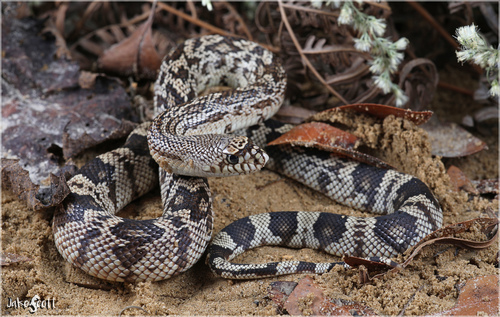
Northern Pine Snake
The Eastern Pine Snake, Pituophis melanoleucus, is a striking serpent with bold patterns, known for its dramatic defensive hissing. It thrives in pine forests, contributing to ecosystem balance by preying on rodents, thus playing an integral role in maintaining the local ecological equilibrium.
15-20 years
Lifespan
Length: 1.2192 - 1.8288 m
Size
Brown, Black
Color
Low
Aggression
Least Concern
Conservation Status
Decreasing
Population Trend
Characteristics
Pituophis melanoleucus, commonly known as the Eastern Pine Snake, is a sizable, non-venomous snake found in the southeastern United States. It inhabits sandy soils of pine forests and agricultural fields. Known for its loud hissing and tail vibration as a defensive behavior, it plays a vital role in controlling rodent populations.
Distribution Range of the Northern Pine Snake
Pituophis melanoleucus, commonly known as the Eastern Pine Snake, is native to the eastern United States. Its geographical distribution includes parts of the southeastern United States, extending from New Jersey and Long Island, New York, south to Florida, and west to the Mississippi River. Its range includes states such as North Carolina, South Carolina, Georgia, Alabama, and Louisiana.
Northern Pine Snake's Habitat
Environmental Conditions
The Eastern Pine Snake typically inhabits open pine forests, sandy pine barrens, and dry, sandy areas with well-drained soils. These environments often feature sparse vegetation, with a mix of pine, oak, and other hardwood trees. The species is well-adapted to environments that have undergone periodic fire, which maintains the open canopy and sandy ground conditions it prefers.
Ecological Niche
Pituophis melanoleucus is a terrestrial snake that primarily preys on small mammals, birds, and eggs. It is a burrowing species, known to make use of its strong body to excavate and modify burrows for shelter and hunting. This adaptation allows it to thrive in its sandy, open habitats, where it can effectively hunt and avoid predators. The snake also plays a role in controlling the populations of its prey species, thus maintaining ecological balance in its native environments.
Copyright @ Nature Style Limited. All Rights Reserved.
 English
English